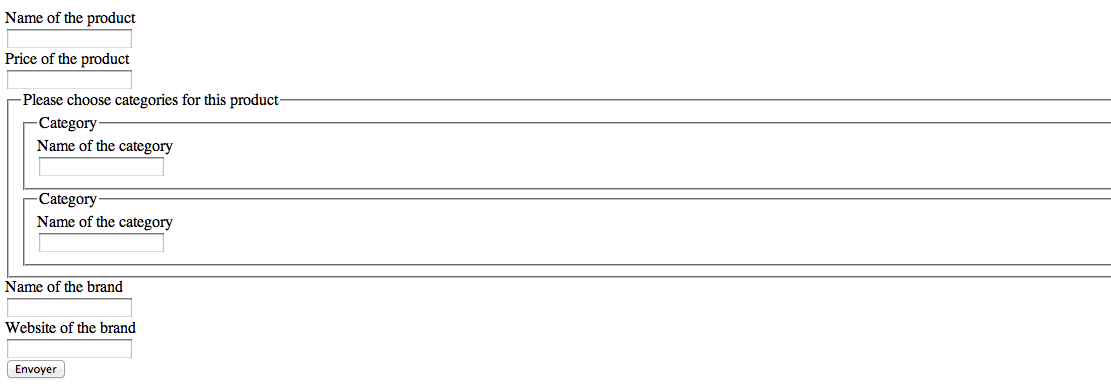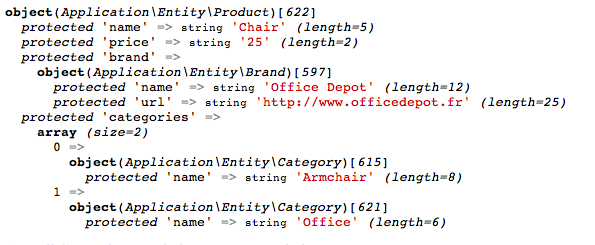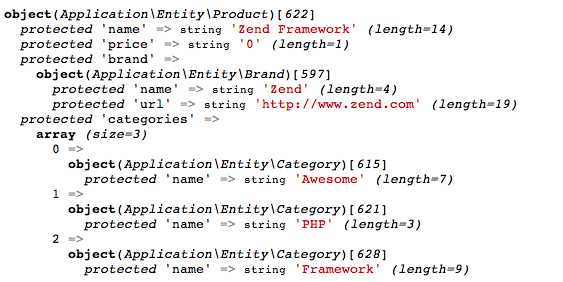Reference
Form Collections
Often, fieldsets or elements in your forms will correspond to other domain objects. In some cases, they may correspond to collections of domain objects. In this latter case, in terms of user interfaces, you may want to add items dynamically in the user interface — a great example is adding tasks to a task list.
This document is intended to demonstrate these features. To do so, we first need to define some domain objects that we'll be using.
namespace Application\Entity;
class Product
{
/**
* @var string
*/
protected $name;
/**
* @var int
*/
protected $price;
/**
* @var Brand
*/
protected $brand;
/**
* @var array
*/
protected $categories;
/**
* @param string $name
* @return self
*/
public function setName($name)
{
$this->name = $name;
return $this;
}
/**
* @return string
*/
public function getName()
{
return $this->name;
}
/**
* @param int $price
* @return self
*/
public function setPrice($price)
{
$this->price = $price;
return $this;
}
/**
* @return int
*/
public function getPrice()
{
return $this->price;
}
/**
* @param Brand $brand
* @return self
*/
public function setBrand(Brand $brand)
{
$this->brand = $brand;
return $this;
}
/**
* @return Brand
*/
public function getBrand()
{
return $this->brand;
}
/**
* @param Category[] $categories
* @return self
*/
public function setCategories(array $categories)
{
$this->categories = $categories;
return $this;
}
/**
* @return Category[]
*/
public function getCategories()
{
return $this->categories;
}
}
class Brand
{
/**
* @var string
*/
protected $name;
/**
* @var string
*/
protected $url;
/**
* @param string $name
* @return self
*/
public function setName($name)
{
$this->name = $name;
return $this;
}
/**
* @return string
*/
public function getName()
{
return $this->name;
}
/**
* @param string $url
* @return self
*/
public function setUrl($url)
{
$this->url = $url;
return $this;
}
/**
* @return string
*/
public function getUrl()
{
return $this->url;
}
}
class Category
{
/**
* @var string
*/
protected $name;
/**
* @param string $name
* @return self
*/
public function setName($name)
{
$this->name = $name;
return $this;
}
/**
* @return string
*/
public function getName()
{
return $this->name;
}
}
A Product has two scalar properties, name and price, a
1:1 relationship (one Product has one Brand), and a 1:N relationship (one
Product has many Category instances).
Creating Fieldsets
The first step is to create three fieldsets. Each fieldset will contain all the fields and relationships for a specific entity.
Here is the Brand fieldset:
namespace Application\Form;
use Application\Entity\Brand;
use Zend\Form\Element;
use Zend\Form\Fieldset;
use Zend\InputFilter\InputFilterProviderInterface;
use Zend\Hydrator\ClassMethods as ClassMethodsHydrator;
class BrandFieldset extends Fieldset implements InputFilterProviderInterface
{
public function __construct()
{
parent::__construct('brand');
$this->setHydrator(new ClassMethodsHydrator(false));
$this->setObject(new Brand());
$this->add([
'name' => 'name',
'options' => [
'label' => 'Name of the brand',
],
'attributes' => [
'required' => 'required',
],
]);
$this->add([
'name' => 'url',
'type' => Element\Url::class,
'options' => [
'label' => 'Website of the brand',
],
'attributes' => [
'required' => 'required',
],
]);
}
/**
* @return array
*/
public function getInputFilterSpecification()
{
return [
'name' => [
'required' => true,
],
];
}
}
The fieldset calls the method setHydrator(), giving it a ClassMethods
hydrator, and the setObject() method, giving it an empty Brand instance.
When we validate incoming data, the form will automatically iterate through all the fieldsets it contains populate all sub-objects, in order to return a complete entity.
Notice that the Url element has a type of Zend\Form\Element\Url. This
information will be used to validate the input field. You don't need to manually
add filters or validators for this input as that element provides a reasonable
input specification.
Finally, getInputFilterSpecification() gives the specification for the
remaining input ("name"), indicating that this input is required. Note that
required in the array "attributes" (when elements are added) is only meant to
add the "required" attribute to the form markup (and therefore has semantic
meaning only).
Here is the Category fieldset:
namespace Application\Form;
use Application\Entity\Category;
use Zend\Form\Fieldset;
use Zend\InputFilter\InputFilterProviderInterface;
use Zend\Hydrator\ClassMethods as ClassMethodsHydrator;
class CategoryFieldset extends Fieldset implements InputFilterProviderInterface
{
public function __construct()
{
parent::__construct('category');
$this->setHydrator(new ClassMethodsHydrator(false));
$this->setObject(new Category());
$this->setLabel('Category');
$this->add([
'name' => 'name',
'options' => [
'label' => 'Name of the category',
],
'attributes' => [
'required' => 'required',
],
]);
}
/**
* @return array
*/
public function getInputFilterSpecification()
{
return [
'name' => [
'required' => true,
],
];
}
}
Nothing new here.
Finally, the Product fieldset:
namespace Application\Form;
use Application\Entity\Product;
use Zend\Form\Element;
use Zend\Form\Fieldset;
use Zend\InputFilter\InputFilterProviderInterface;
use Zend\Hydrator\ClassMethods as ClassMethodsHydrator;
class ProductFieldset extends Fieldset implements InputFilterProviderInterface
{
public function __construct()
{
parent::__construct('product');
$this->setHydrator(new ClassMethodsHydrator(false));
$this->setObject(new Product());
$this->add([
'name' => 'name',
'options' => [
'label' => 'Name of the product',
],
'attributes' => [
'required' => 'required',
],
]);
$this->add([
'name' => 'price',
'options' => [
'label' => 'Price of the product',
],
'attributes' => [
'required' => 'required',
],
]);
$this->add([
'type' => BrandFieldset::class,
'name' => 'brand',
'options' => [
'label' => 'Brand of the product',
],
]);
$this->add([
'type' => Element\Collection::class,
'name' => 'categories',
'options' => [
'label' => 'Please choose categories for this product',
'count' => 2,
'should_create_template' => true,
'allow_add' => true,
'target_element' => [
'type' => CategoryFieldset::class,
],
],
]);
}
/**
* Should return an array specification compatible with
* {@link Zend\InputFilter\Factory::createInputFilter()}.
*
* @return array
*/
public function getInputFilterSpecification()
{
return [
'name' => [
'required' => true,
],
'price' => [
'required' => true,
'validators' => [
[
'name' => 'Float',
],
],
],
];
}
}
We have a lot of new things here!
First, notice how the brand element is added: we specify it to be of type
Application\Form\BrandFieldset. This is how you handle a 1:1
relationship. When the form is validated, the BrandFieldset will first be
populated, and will return a Brand entity (as we have specified a
ClassMethods hydrator, and bound the fieldset to a Brand entity using the
setObject() method). This Brand entity will then be used to populate the
Product entity by calling the setBrand() method.
The next element shows you how to handle 1:N relationships. The type is
Zend\Form\Element\Collection, which is a specialized element to handle such
cases. As you can see, the name of the element ("categories") perfectly matches
the name of the property in the Product entity.
This element has a few interesting options:
count: this is how many times the element (in this case, a category) has to be rendered. We've set it to2in this example.should_create_template: if set totrue, it will generate a template markup in a<span>element, in order to simplify adding new element on the fly (we will speak about this one later).allow_add: if set totrue(which is the default), dynamically added elements will be retrieved and validated; otherwise, they will be completely ignored. This, of course, depends on what you want to do.target_element: this is either an element or, as this is the case in this example, an array that describes the element or fieldset that will be used in the collection. In this case, thetarget_elementis aCategoryfieldset.
The Form Element
So far, so good. We now have our fieldsets in place. But those are fieldsets,
not forms. And only Form instances can be validated. So here is the form:
namespace Application\Form;
use Zend\Form\Element;
use Zend\Form\Form;
use Zend\InputFilter\InputFilter;
use Zend\Hydrator\ClassMethods as ClassMethodsHydrator;
class CreateProduct extends Form
{
public function __construct()
{
parent::__construct('create_product');
$this->setAttribute('method', 'post')
$this->setHydrator(new ClassMethodsHydrator(false));
$this->setInputFilter(new InputFilter());
$this->add([
'type' => ProductFieldset::class,
'options' => [
'use_as_base_fieldset' => true,
],
]);
$this->add([
'type' => Element\Csrf::class,
'name' => 'csrf',
]);
$this->add([
'name' => 'submit',
'attributes' => [
'type' => 'submit',
'value' => 'Send',
],
]);
}
}
CreateProduct only defines a Product fieldset, as well as some other useful
fields (CSRF for security, and a Submit button).
Notice the use_as_base_fieldset option. This option is here to say to the
form: "hey, the object I bind to you is, in fact, bound to the fieldset that is
the base fieldset." This will be to true in most situations.
This approach allows each entity to have its own Fieldset, and enables re-use.
You describe the elements, the filters, and validators for each entity only
once, and the concrete Form instance will only compose those fieldsets. You no
longer have to add the "username" input to every form that deals with users!
Integrating with zend-mvc
Now, let's create a zend-mvc controller action:
/**
* @return array
*/
public function indexAction()
{
$form = new CreateProduct();
$product = new Product();
$form->bind($product);
$request = $this->getRequest();
if ($request->isPost()) {
$form->setData($request->getPost());
if ($form->isValid()) {
var_dump($product);
}
}
return [
'form' => $form,
];
}
All the controller does is:
- Create a form instance.
- Bind it to an object.
- Validate it and/or return the form instance for later use by the view.
Integration with zend-view
And finally, the view:
<?php
$form->setAttribute('action', $this->url('home'));
$form->prepare();
echo $this->form()->openTag($form);
$product = $form->get('product');
// The name and price can be rendered as regular elements:
echo $this->formRow($product->get('name'));
echo $this->formRow($product->get('price'));
// Categories are rendered as a collection:
echo $this->formCollection($product->get('categories'));
$brand = $product->get('brand');
// Since the brand is a 1:1 relationship, its elements are rendered normally:
echo $this->formRow($brand->get('name'));
echo $this->formRow($brand->get('url'));
// And finally, we render the CSRF and submit elements:
echo $this->formHidden($form->get('csrf'));
echo $this->formElement($form->get('submit'));
echo $this->form()->closeTag();
A few new things here :
- the
prepare()method. You must call it prior to rendering anything in the view (this function is only meant to be called in views, not in controllers). - the
FormRowhelper renders a label (if present), the input itself, and errors. - the
FormCollectionhelper will iterate through every element in the collection, and render every element with theFormRowhelper (you may specify an alternate helper if desired, using thesetElementHelper()method on thatFormCollectionhelper instance). If you need more control about the way you render your forms, you can iterate through the elements in the collection, and render them manually one by one.
Here is the result:

Collections are wrapped inside a fieldset, and every item in the collection is
itself wrapped in the fieldset. In fact, the Collection element uses label
for each item in the collection, while the label of the Collection element
itself is used as the legend of the fieldset. You must have a label on every
element in order to use this feature. If you don't want the fieldset created,
but just the elements within it, add a boolean false as the second parameter
of the FormCollection view helper.
If you validate, all elements will show errors (this is normal, as we've marked them as required). As soon as the form is valid, this is what we get :

The bound object is completely filled with the object instances we specified, not with arrays!
Adding New Elements Dynamically
Remember that should_create_template flag? We're going to use it now.
Often, forms are not completely static. In our case, let's say that we don't want only two categories, but we want the user to be able to add more at runtime. zend-form enables this capability. First, let's see what it generates when we ask it to create a template:

The collection generates two fieldsets (the two categories) plus a span with a
data-template attribute that contains the full HTML code to copy to create a
new element in the collection. The value __index__ (this is the placeholder
generated) must be changed to a valid value. Currently, we have 2 elements
(categories[0] and categories[1], so __index__ must be changed to 2.
If you want, this placeholder (__index__ is the default) can be changed using
the template_placeholder option key:
$this->add([
'type' => Element\Collection::class,
'name' => 'categories',
'options' => [
'label' => 'Please choose categories for this product',
'count' => 2,
'should_create_template' => true,
'template_placeholder' => '__placeholder__',
'target_element' => [
'type' => CategoryFieldset::class,
],
],
]);
First, let's add a small button "Add new category" anywhere in the form:
<button onclick="return add_category()">Add a new category</button>
The add_category function will need to do the following:
- First, count the number of elements we already have.
- Get the template from the
span'sdata-templateattribute. - Change the placeholder to a valid index.
- Add the element to the DOM.
The following is a potential implementation:
function add_category() {
var currentCount = $('form > fieldset > fieldset').length;
var template = $('form > fieldset > span').data('template');
template = template.replace(/__index__/g, currentCount);
$('form > fieldset').append(template);
return false;
}
(Note: the above example assumes $() is defined, and equivalent to jQuery's
$() function, Dojo's dojo.query, etc.)
One small remark about template.replace: the example uses currentCount and
not currentCount + 1, as the indices are zero-based (so, if we have two
elements in the + collection, the third one will have the index 2).
Now if we validate the form, it will automatically take into account this new element by validating it, filtering it and retrieving it:

If you don't want to allow adding elements in a collection, you must set the
option allow_add to false. This way, even if new elements are added, they
won't be validated and hence, not added to the entity. Also, if we don't want
elements to be added, we don't need the data template, either.
Here's how you both disable adding dynamic elements, and disable the template:
$this->add([
'type' => Element\Collection::class,
'name' => 'categories',
'options' => [
'label' => 'Please choose categories for this product',
'count' => 2,
// Do not allow adding:
'allow_add' => false,
// Do not display the index template:
'should_create_template' => false,
'target_element' => [
'type' => CategoryFieldset::class,
],
],
]);
There are some limitations to this capability:
- Although you can add new elements and remove them, you CANNOT remove more
elements in a collection than the initial count (for instance, if your code
specifies
count == 2, you will be able to add a third one and remove it, but you won't be able to remove any others. If the initial count is 2, you must have at least two elements. - Dynamically added elements have to be added at the end of the collection. They can be added anywhere (these elements will still be validated and inserted into the entity), but if the validation fails, this newly added element will be automatically placed at the end of the collection.
Validation groups for fieldsets and collection
Validation groups allow you to validate a subset of fields.
As an example, although the Brand entity has a url property, we don't want
the user to specify it in the creation form (but may wish to later in the "Edit
Product" form, for instance). Let's update the view to remove the url input:
<?php
$form->setAttribute('action', $this->url('home'));
$form->prepare();
echo $this->form()->openTag($form);
$product = $form->get('product');
echo $this->formRow($product->get('name'));
echo $this->formRow($product->get('price'));
echo $this->formCollection($product->get('categories'));
$brand = $product->get('brand');
echo $this->formRow($brand->get('name'));
echo $this->formHidden($form->get('csrf'));
echo $this->formElement($form->get('submit'));
echo $this->form()->closeTag();
This is what we get:

The url input has disappeared, but even if we fill every input, the form won't
validate. In fact, this is normal. We specified in the input filter that the
url is a required field, so if the form does not have it, it won't validate,
even though we didn't add it to the view!
Of course, you could create a BrandFieldsetWithoutUrl fieldset, but this would
require a lot of duplicate code.
The solution: validation groups. A validation group is specified in a Form
object (hence, in our case, in the CreateProduct form) by giving an array of
all the elements we want to validate. Our CreateProduct class now looks like
this:
namespace Application\Form;
use Zend\Form\Element;
use Zend\Form\Form;
use Zend\InputFilter\InputFilter;
use Zend\Hydrator\ClassMethods as ClassMethodsHydrator;
class CreateProduct extends Form
{
public function __construct()
{
parent::__construct('create_product');
$this->setAttribute('method', 'post');
$this->setHydrator(new ClassMethodsHydrator());
$this->setInputFilter(new InputFilter());
$this->add([
'type' => ProductFieldset::class,
'options' => [
'use_as_base_fieldset' => true,
],
]);
$this->add([
'type' => Element\Csrf::class,
'name' => 'csrf',
]);
$this->add([
'name' => 'submit',
'attributes' => [
'type' => 'submit',
'value' => 'Send',
],
]);
$this->setValidationGroup([
'csrf',
'product' => [
'name',
'price',
'brand' => [
'name',
],
'categories' => [
'name',
],
],
]);
}
}
Don't forget to add the CSRF element, as we want it to be validated too (but
notice that the example omits the submit element, as we don't care about its
value). You can also recursively select the elements if desired.
There is one limitation currently: validation groups for collections are set on a per-collection basis, not per-element in a collection basis. This means you cannot say, "validate the name input for the first element of the categories collection, but don't validate it for the second one."
Now, the form validates (and the url is set to null as we didn't specify it).
Preventing validation from wiping out previous collection items
In some cases, you may be representing collections within a model, but not validating them; as an example, if you use a validation group that excludes the collections from validation so that they remain untouched after binding.
Starting in 2.8.4, behavior around collections changed in order to fix some underlying bugs. One such change is that if a collection is found in a form, but has no associated data, an empty array is assigned to it, even when not in the validation group. This effectively wipes out the collection data when you bind values.
To prevent this behavior, starting in 2.9.1 you may pass an optional second
argument to bindValues() on either a fieldset or collection,
$validationGroup; when present, these instances will first check if the
collection is in the validation group before binding the value; if it is not,
the collection will not be represented. The Form class has been updated to
pass the validation group, if present, on to fieldset and collection instances
when performing bindValues() operations.
For more details, refer to the following issues:
- zendframework/zend-form#19
- zendframework/zend-form#102
- zendframework/zend-form#103
- zendframework/zend-form#106
Found a mistake or want to contribute to the documentation? Edit this page on GitHub!